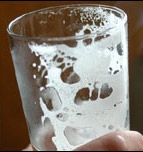This might not go over well in Belgium. I pick Belgium because that is notoriously the land of non-styles, and although the Brewers Association does not define any additional styles in the 2008 Beer Style Guidelines there are 11 new categories.
Before getting to the list, a few words from Carl Kins, a Belgian beer enthusiast who judges at the Great American beer festival and world beer Cup: “We Belgians do not like categorization that much.”
Also, I hope Ron Pattinson is looking on and has some comments on the Leipzig-style Göse (maybe even a post I can just link to). So I’ll also drop that in before the list of what’s new.
The original versions of this style of beer were spontaneously fermented, similarly to Belgian style gueuze/lambic beers. No current German Göse breweries introduce any other microorganism into the fermentation other than pure beer yeast strains. This style description is indicative of traditional and original Göse. Complexity of acidic, flavor and aroma typical of original-style Göse should be contributed by developing acidity through introducing appropriate wild yeast and bacteria into the fermentation.
Göse is enjoyed fresh, carbonated, and cloudy, with yeast character and may have evidence of continued fermentation activity. Light in color, negligible malt and hop character. Some versions may have the spicy character of added coriander. Salt (table salt) character is also permissible in low amounts. Character of lactic acid is evident. Horsey, leathery, earthy aroma and flavors contributed by Brettanomyces yeasts may be evident but have a very low profile, as this beer is not excessively aged. Overall complexity of flavors and aromas are sought. Balance between acidity, and yeast-enhanced, spice and refreshment is ideal.
Original Gravity (ºPlato):
1.040-1.046 (10-11.5 ºPlato)
Apparent Extract/Final Gravity (ºPlato):
1.008-1.012 (2-3 ºPlato)
Alcohol by Weight (Volume):
3.5-4% (4.4-5%)
Bitterness (IBU): 10-15
Color SRM (EBC): 3-6 (6-12 EBC)
Now, the other new stuff.
Fresh Hop Ale
Ales which are hopped exclusively with fresh and un-dried (“wet”) hops.
American-Belgo Styles Ales
These beers portray the unique characters imparted by yeasts typically used in fruity and big Belgian-style ales.
Belgian-Style Blonde Ale
Belgian-style blonde ales are characterized by low yet evident hop bitterness, flavor and sometimes aroma.
Australasian-Style Pale Ale
This style is a mild, pale, light-bodied ale with a color varying from light to amber. Hop bitterness and flavor range from very low to low.
Out of Category- Traditionally Brewed Beers
There are many excellent and popular beers that are brewed with traditional ingredients and processes, yet their character may vary from styles currently defined or included in these guidelines.
Wood- and Barrel- Aged Beer
Any lager, ale, or hybrid beer, either a traditional style or a unique experimental beer that has been aged for a period of time in a wooden barrel or in contact with wood.
Wood- and Barrel- Aged Pale to Amber Beer
Any classic style or unique experimental beer that has been aged for a period of time in a wooden barrel or in contact with wood.
Wood- and Barrel- Aged Dark Beer
Any classic style or unique experimental style of dark beer beer can be wood or barrel-aged for a period of time in a wooden barrel or in contact with wood.
Wood- and Barrel- Aged Strong Beer
Any strong classic style or unique, experimental style of beer can bee wood or barrel-aged for a period of time in a wooden barrel or in contact with wood.
Wood- and Barrel- Aged Sour Beer
A wood- or barrel- aged beer is any lager, ale, or hybrid beer, either a traditional style or a unique experimental beer that has been aged for a period of time in a wooden barrel or in contact with wood and has developed a bacterial induced natural acidity.
 And what I failed to mention yesterday about Green Lakes Organic Ale is that it poured with a billowing head that left elegant lacing on the sides of the glass. That certainly added to an impression the beer was fresh and alive.
And what I failed to mention yesterday about Green Lakes Organic Ale is that it poured with a billowing head that left elegant lacing on the sides of the glass. That certainly added to an impression the beer was fresh and alive.